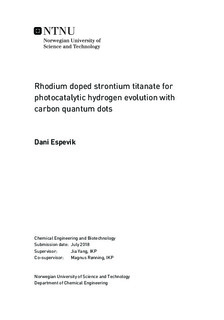Rhodium doped strontium titanate for photocatalytic hydrogen evolution with carbon quantum dots
Master thesis
Permanent lenke
http://hdl.handle.net/11250/2580066Utgivelsesdato
2018Metadata
Vis full innførselSamlinger
Sammendrag
The worlds energy demands continue to increase, and the reserves of fossil fuels are limited. Therefore the world is in need of finding different energy sources. Production of hydrogen by splitting water, using photocatalysis is a potential solution. Previous studies have shown that strontium titanate doped with rhodium is active in the visible light area. The purpose of this study was to synthesize rhodium doped strontium titanate and enhance the photocatalytic hydrogen evolution with carbon quantum dots from a solution containing a sacrificial reagent.Strontium titanate and rhodium doped strontium titanate was synthesized from titanium dioxide, strontium carbonate, and rhodium(III) oxide, using the solid state reaction method. The XRD specter showed the characteristic peaks for strontium titanate for all of the synthesized samples along with some impurity peaks. Previous studies have shown that the Sr/(Ti+Rh) ratio is important for achieving high activity from Rh doped strontium titanate. The ratio was investigated using ICP-MS. UV-vis DRS measurements were used to obtain the absorbance spectra of the synthesized samples. The rhodium doped strontium titanate sample prepared at 1100 degrees Celsius (B8.Rh) is considered to be the most active of the synthesized samples and is exhibiting all the characteristics found in literature for Rh doped strontium titanate except for having a slightly larger band gap. However, the titanium dioxide, P25, from Sigma Aldrich with photodeposited Pt evolved hydrogen at a much higher rate than the B8.Rh with photodeposited Pt. Carbon quantum dots was loaded on to the B8.Rh, but completely hampered the photocatalytic activity.
